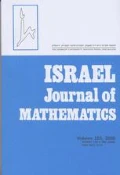Abstract
We consider a finitely defined game where the payoff for each player at each terminal point of the game is not a fixed quantity but varies according to probability distributions on the terminal points induced by the strategies chosen. We prove that if these payoffs have an upper-semicontinuous and convex valued structure then the game has an equilibrium. For this purpose the concept of a myopic equilibrium is introduced, a concept that generalizes that of a Nash equilibrium and applies to the games we consider. We answer in the affirmative a question posed by A. Neyman: if the payoffs of an infinitely repeated game of incomplete information on one side are a convex combination of the undiscounted payoffs and payoffs from a finite number of initial stages, does the game have an equilibrium?
Similar content being viewed by others
References
F. D. Ancel, The role of countable dimensionality in the theory of cell-like relations, Transactions of the American Mathematical Society 287 (1985), 1–40.
R. Aumann and M. Maschler, Repeated Games with Incomplete Information, MIT Press, Cambridge, MA, 1995.
C. Biasi and T. Monis, Weak local Nash equilibrium, Topological Methods of Nonlinear Analysis 41 (2013), 409–419.
D. Blackwell, An analogue of the minimax theorem for vector payoffs, Pacific Journal of Mathematics 6 (1965), 1–8.
W. Bolt and F. Tieman, On myopic equilibria in dynamic games with endogenous discounting, International Monetary Fund Working Papers, Paper no. 06/302, 2006.
S. Govindan and R. Wilson, Structure theorems for game trees, Proceedings of the National Academy of Sciences of the United States of America 99 (2002), 9077–9080.
S. Govindan and R. Wilson, Essential equilibria, Proceedings of the National Academy of Sciences of the United States of America 102 (2005), 15706–15711.
S. Hart, Non-zero sum two-person repeated games with incomplete information, Mathematics of Operations Research 10 (1985), 117–153.
E. Kohlberg and J.-F. Mertens, On the strategic stability of equilibria, Econometrica 54 (1986), 1003–1037.
D. Kreps and R. Wilson, Sequential equilibria, Econometrica 50 (1982), 863–894.
H. Kuhn, Extensive games and the problem of information, in Contributions to the Theory of Games. I, Annals of Mathematics Studies, Vol. 28, Princeton University Press, Princeton, NJ, 1953, pp. 193–216.
J.-F. Mertens, Stable equilibria: A reformulation. Part I. Definition and basic properties, Mathematics of Operations Research 14 (1989), 575–625.
J.-F. Mertens, Stable equilibria: A reformulation. Part II., Discussion of the definition and further results, Mathematics of Operations Research 16 (1991), 694–753.
J. Nash, Equilibrium points in n-person games, Proceedings of the National Academy of Sciences of the United States of America 36 (1950), 48–49.
A. Neyman, private communication, 2016.
W. H. Sandholm, Population Games and Evolutionary Dynamics, Economic Learning and Social Evolution, MIT Press, Cambridge, MA, 2010.
R. Selten, A reexamination of the perfectness concept for equilibrium points in extensive games, International Journal of Game Theory 4 (1975), 25–55.
R. S. Simon, S. Spież and H. Toruńczyk, The existence of equilibria in certain games, separation for families of convex functions and a theorem of Borsuk-Ulam type, Israel Journal of Mathematics 92 (1995), 1–21.
R. S. Simon, S. Spież and H. Toruńczyk, Equilibrium existence and topology in games of incomplete information on one side, Transactions of the American Mathematical Society 354 (2002), 5005–5026.
S. Sorin and S. Zamir, A two-person game with lack of information on one and one-half sides, Mathematics of Operations Research 10 (1985), 17–23.
C. Stapenhorst, Noisy Signalling in the Principal-Agent Problem, M. Sc. Dissertation, London School of Economics, 2016.
Author information
Authors and Affiliations
Corresponding author
Additional information
Dedicated to the memory of Andrzej Granas (1929–2019)
Rights and permissions
About this article
Cite this article
Simon, R., Spież, S. & Toruńczyk, H. Games of incomplete information and myopic equilibria. Isr. J. Math. 241, 721–748 (2021). https://doi.org/10.1007/s11856-021-2111-7
Received:
Revised:
Published:
Issue Date:
DOI: https://doi.org/10.1007/s11856-021-2111-7



